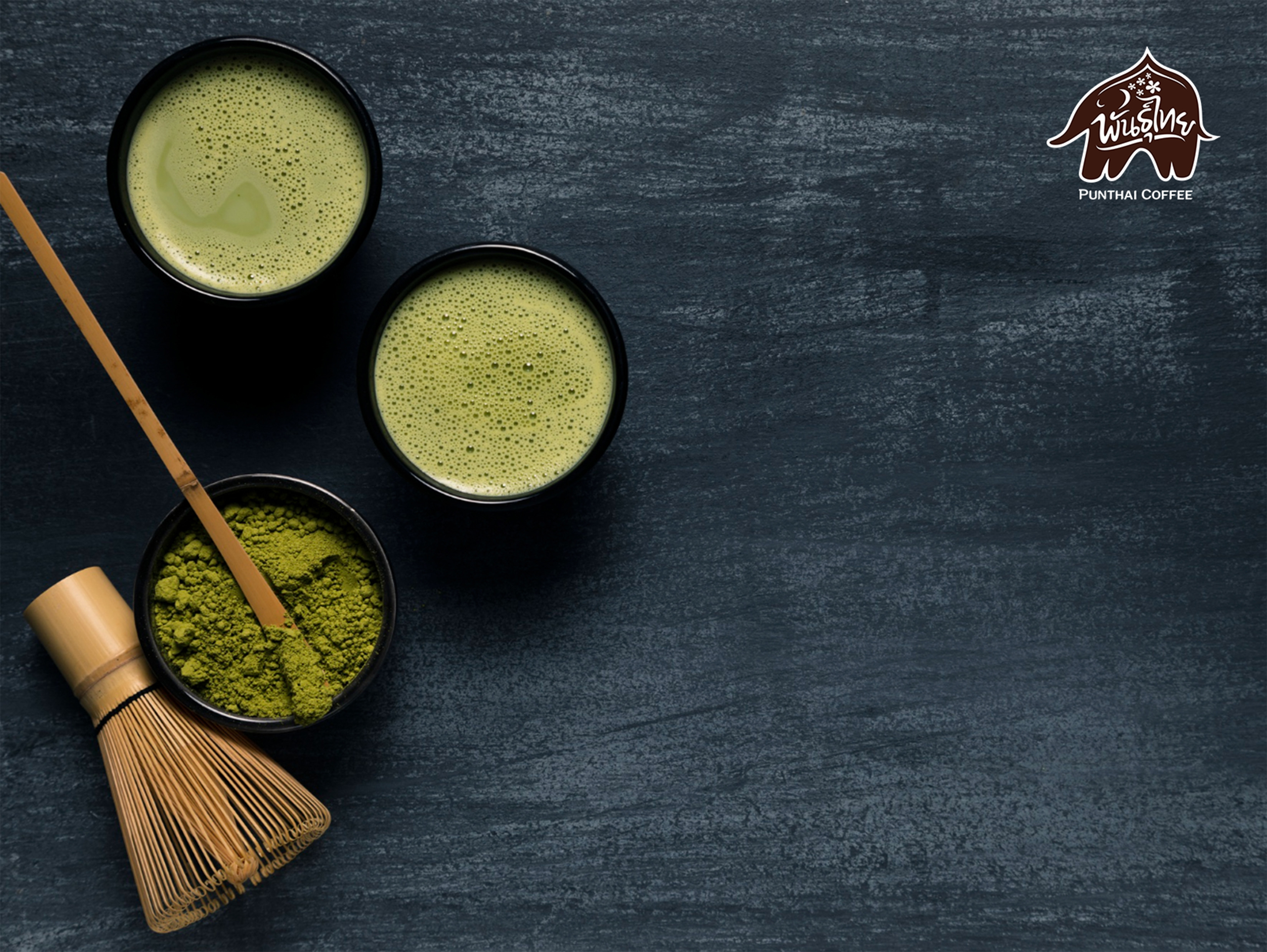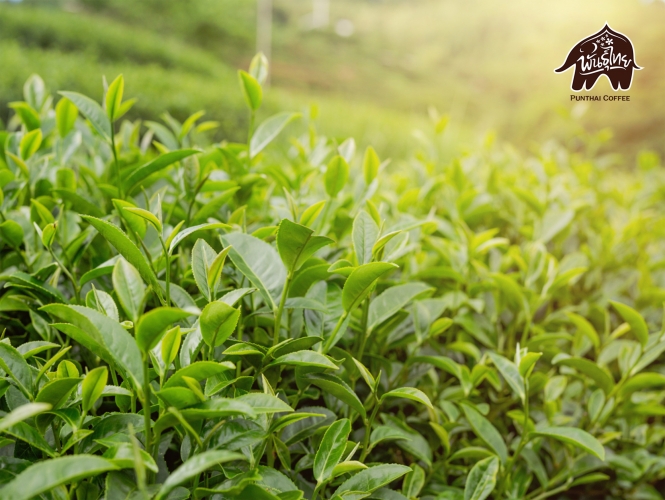
Revealing the Tea Secrets: The Difference Between Matcha and Green Tea
Ever found yourself pondering between ordering green tea and matcha, staring at the menu for what seems like ages? Many still confuse green tea and matcha as one and the same, but in reality, from cultivation to brewing and consumption, they differ significantly. Today, PunThai will uncover the mysteries behind what makes green tea and matcha distinct. We'll delve into their origins, brewing methods, and drinking practices together.

Getting to Know Green Tea and Matcha

Origin of Green Tea
Green tea, or Ryokucha, traces its origins back to China over 4,000 years ago. The story begins with a Japanese Buddhist monk named Eichu from the Bonshakuji Temple in Iiji Prefecture, who journeyed to China as an envoy to learn various disciplines, including the discovery of green tea. He brought back green tea to offer to Emperor Saga, who appreciated its taste and recognized its health benefits. Thus, the consumption of green tea began among the aristocracy before spreading to the general populace.
Japanese people began cultivating tea plants and inventing various methods to produce different types of green tea, such as matcha, sencha, genmaicha, kyokuro, etc. They also developed the tea ceremony, known as "chado" or "sado," which became renowned worldwide.
While the history of green tea originates from China, the Japanese have developed and disseminated the culture of tea drinking extensively, making it a symbol of Japan renowned globally.
What is Green Tea?
Green tea, or Green Sencha, originates from China. It is characterized by dried green tea leaves with a grassy aroma, a mild, slightly sweet taste, and a light greenish-yellow, clear infusion when brewed. Sometimes, it's blended with colorants and scents like jasmine to suit the taste of Thai people better.
The process of producing green tea involves plucking the tea leaves grown in open fields, then drying and roasting them with hot air or pan-frying. This process differs from that of matcha, as green tea does not undergo fermentation or grinding of tea leaves.
Due to its simpler production process compared to matcha, green tea is more affordable but maintains the original quality and taste of green tea.
Types of Green Tea
1. Sencha:
- Dried green tea leaves roasted to dryness.
- Sweet taste, grassy aroma, easy to drink.
- Light green infusion.
2. Genmaicha:
- Green tea mixed with roasted or popped rice.
- Distinctive aroma.
- Light yellow infusion.
3. Hojicha:
- Green tea leaves roasted to produce a reddish-brown color.
- Unique aroma.
- Clear brown infusion.
4. Matcha:
- Finely ground powder of green tea leaves.
- Dissolves in water when brewed.
- Dark green, murky color when dissolved.
- Each type has different production processes, shapes, colors, aromas, tastes, and brewing methods.
What is Matcha?
Matcha is a special type of green tea with distinctive characteristics originating from Japan. It involves meticulous cultivation and harvesting processes before grinding tea leaves into a fine powder, resulting in a vibrant green color with high nutritional value from chlorophyll.
What sets matcha apart is its unique brewing method, inherited from traditional Japanese tea ceremonies. It involves whisking the powdered tea with hot water until frothy, requiring exceptional skill and concentration, making it a high art form in Japan.
While modern green tea brewing methods may vary with time and culture, matcha preparation remains faithful to Japan's traditional practices, resulting in a uniquely flavorful and nutritious beverage. It has become a highly valued art of tea brewing globally.
Types of Matcha
Matcha can be categorized into three main grades based on harvesting stages:
1. Ceremonial Grades: Highest quality matcha harvested in the first round, offering a smooth, green flavor. It's expensive and suitable for traditional tea ceremonies.
2. Culinary Grades: Matcha from the second harvest round, slightly lower in quality than ceremonial grades, suitable for culinary uses and beverages.
3. Ingredient Grades: Matcha from subsequent harvest rounds, lower in quality and bitter in taste. Suitable for ingredient use in foods and supplements.
Green Tea vs Matcha: How Are They Different?

1. Different Cultivation Methods
Green Tea Cultivation
Green tea is predominantly produced in China, accounting for over 80% of the world's green tea. It is typically grown in open areas where sunlight can directly reach the plants.
Matcha Cultivation
Matcha, a high-quality special green tea from Japan, follows a different cultivation method. In the final 2-3 weeks before harvesting, matcha plants are shaded to protect them from direct sunlight.
This shading process during the final weeks enhances the accumulation of theanine, a crucial compound that contributes to matcha's distinct flavor and health benefits, distinguishing it from regular green tea. Therefore, the production process of matcha is meticulous and requires greater attention to detail compared to other types of green tea to ensure high-quality yields.
2. Different Processing Methods
Green Tea Processing
After harvesting green tea leaves, various processing methods like sun-drying, pan-firing, or steaming are employed to halt oxidation. Then, the leaves are either oven-dried or air-dried, resulting in dried, curled green tea leaves.
Matcha Processing
Matcha, being a high-quality green tea, undergoes distinctive processing methods. After harvesting, the leaves are promptly steamed and dried with hot air to halt oxidation and preserve nutrients to the fullest. Then, stems and veins are removed, leaving only pure leaf material, which is ground into a fine, vibrant green powder. The meticulous processing of matcha aims to maintain the freshness and nutritional value of the tea leaves, resulting in a distinctive, flavorful powder.

3. Different Leaf Characteristics
Green Tea Leaves
Green tea leaves are typically dried and retain their original leaf shape. The fineness of the leaves varies depending on the tea cultivar and processing methods.
Matcha Leaves
Matcha leaves are ground into a very fine powder, as they undergo grinding from fresh young shoots and green tea leaves. This powder is the smallest food particle globally, resembling finely ground flour. The matcha powder is much finer compared to regular green tea powder.
The significant difference in leaf characteristics is that green tea leaves are dried, while matcha leaves are ground into a very fine powder, resulting in a deep green powder.
4. Different Aromas
Aroma of Green Tea
Green tea typically has a distinct aroma derived from the tea leaves themselves. Some brewing methods may result in a slightly seaweed-like scent. In Thailand, green tea leaves are often roasted with jasmine flowers, creating a sweet, fragrant aroma.
Aroma of Matcha
Matcha, produced from the tender leaves of high-quality green tea, possesses a delicate aroma distinct from regular green tea. It has a fresh, lively scent of young tea leaves, coupled with a rich, complex taste. The aroma of matcha is one of its highlights, captivating tea lovers worldwide.
The unique aroma of matcha is attributed to various compounds obtained through meticulous processing. These include terpenoids, phenolic compounds, and newly formed aromatic compounds from the breakdown of certain substances like amino acids, resulting in a unique and enticing aroma.
5. Different Flavors
Flavor of Green Tea
Regular green tea often shares a similar flavor profile, with earthy and grassy notes, a subtle sweetness, and a light body, providing a refreshing sensation.
Flavor of Matcha
Matcha, being a high-quality green tea, maintains earthy and grassy notes similar to regular green tea, but it offers a more complex and distinct taste. It incorporates bitter and sweet flavors in harmony, along with a dense and robust body.
The special flavor profile of matcha results from its meticulous processing, ensuring the retention of various nutrients from the tea leaves. Additionally, the dissolution of certain compounds like amino acids during processing contributes to its unique bitter-sweet taste.
In conclusion, while matcha may appear similar to green tea, it offers a remarkable and distinctive flavor experience, making it a premium tea choice.

6. Different Colors of Tea
Green Tea Color
It has a clear green color when brewed. This is because it is made from dried tea leaves that have not undergone grinding into fine powder. When left to settle, green tea does not produce much sediment.
Matcha Color
It has a cloudy green color, darker than green tea. The color may vary from light to dark depending on the production methods of each source. Matcha is finely ground into powder, so when brewed, it produces a cloudy and intense green color. When left to settle, matcha powder settles clearly at the bottom of the cup.
The difference in tea color arises from the physical characteristics of the raw materials. Green tea is made from dried leaves, resulting in a clear green color, while matcha is finely ground into powder, resulting in a darker and cloudier tea with sediment when left to settle.
7. Different Prices
Price of Green Tea
The cultivation and production process are not overly complicated, resulting in relatively low production costs and therefore a lower selling price.
Price of Matcha
It involves more complex cultivation, harvesting, and production processes compared to green tea. The intricate production process leads to higher production costs, resulting in a higher price for matcha. The better the quality, the higher the price.
The main price difference lies in the complexity of the production process. Matcha requires more intricate and complex steps, leading to higher production costs and consequently a higher selling price compared to green tea.

8. Different Brewing Methods
Green Tea Brewing Method
The general method of brewing green tea is simple, where dried tea leaves or tea bags are steeped in hot water, resulting in light green or light brown tea. It can be flavored or mixed with milk according to preference.
Matcha Brewing Method
Brewing matcha involves more complex and elaborate methods. Fresh green matcha powder is mixed and whisked into hot water in a special small-sized bowl, using a bamboo whisk to blend. This results in a rich and intense dark green matcha tea. This concentrated matcha tea can then be diluted or mixed with hot milk to create a smoother taste, known as "matcha latte," popular nowadays.
Therefore, matcha brewing is an art that requires expertise and patience, rooted in the traditional Japanese tea ceremony, making matcha a unique green tea with its own distinct culture.
In summary, matcha is a special type of green tea with a production process different from regular green tea. The tea bushes are covered for 30 days before harvesting to prevent the tea leaves from changing to catechin when exposed to sunlight, resulting in a different taste profile.
Subsequently, the green tea leaves are ground into powder without separating the leaf residue, unlike regular green tea, which needs to be filtered before drinking. As a result, drinking matcha provides complete nutrition from the tea leaves, but it tends to have a relatively strong and bitter taste. To make matcha taste smoother, milk is often added, creating the popular "matcha latte" menu that many people enjoy nowadays. This allows consumers to enjoy the special premium matcha tea while receiving its full benefits, like the popular menu "Matcha Latte," made from premium PunThai grown in Chiang Rai province. Our tea leaves are of high quality, grown on high mountains, and harvested at the right time, with meticulous cultivation, harvesting, and production processes to become the "Matcha Latte" menu, which is very popular nowadays.

Premium Maruzen Matcha PunThai Menus
- Matcha Frappe: The intensity of premium matcha blended with the creaminess of fresh milk, blended with ice until smooth. Worth trying at least once.
- Matcha Honey Lime: Light and refreshing, with the sweetness of honey and the tanginess of lime. Invigorating and refreshing, perfect for cooling down.
- Matcha Gelato: Adds a positive twist with the combination of matcha and gelato, blending well with strawberry. Delicious and enjoyable.
- Matcha Latte: Premium Japanese matcha, original recipe. Smooth and mellow in flavor, perfectly complemented by the richness of fresh milk. A must-try!
So, what's the difference between green tea and matcha? After reading this, you should no longer be confused about whether to order green tea or matcha at a café. For those who want to enjoy premium matcha, you can order matcha or other tea menus on PunThai website and follow the great promotions on PunThai’s Facebook page. For those who want to read more informative articles like this, you can find them on PunThai blog.
Reference:
- มัทฉะ กับ ชาเขียว เหมือนกันหรือต่างกันตรงไหน!?
- เผยความลับฉบับ “ มัทฉะ ” เครื่องดื่มยอดฮิตสไตล์ญี่ปุ่น ที่ควรรู้ก่อนดื่ม - Boncafe
- ชาเขียว Green Tea กับ มัทฉะ Matcha สีเขียวเหมือนกัน แล้วต่างกันยังไง
- รวมเรื่องน่ารู้เกี่ยวกับชาเขียวมัทฉะ พร้อมแจกสูตรมัทฉะเข้มข้น ทำตามได้ง่าย ๆ
- ใครว่าชาเขียวแบบไหนก็เหมือนกัน ไม่จริ๊งไม่จริง! | Kiji.life



